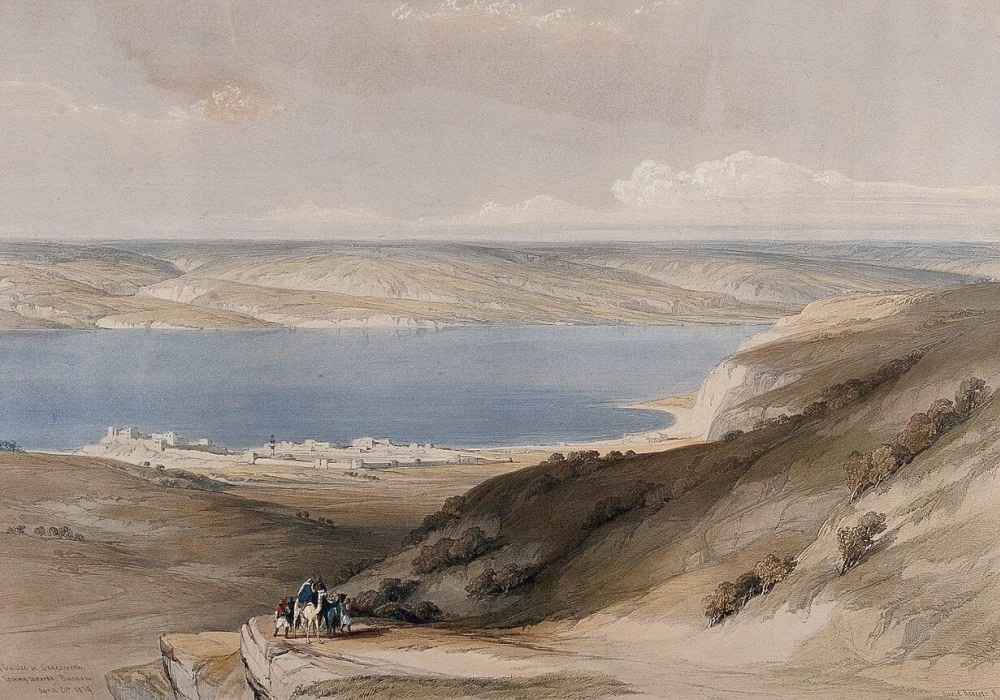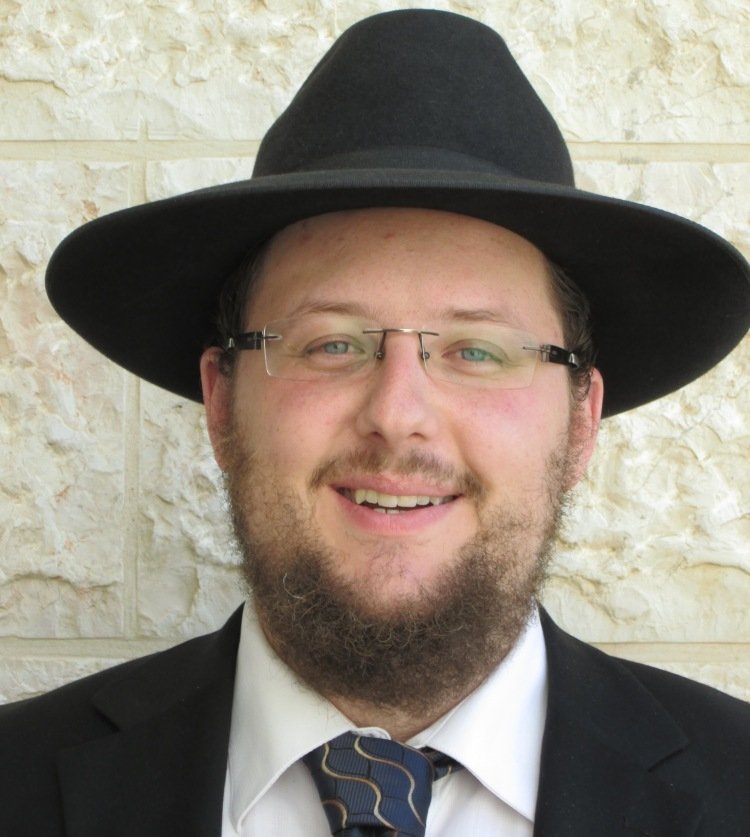 Edit article
Edit articleSeries
The Strip of Argov in the Bashan

Lake Galilee, looking towards Bashan. Louis Haghe after David Roberts, 1842. Wellcome Collection
When recounting the victory over Og, king of Bashan, Moses mentions the strip of Argov, a large part of (or a territory coterminous with) the Bashan — roughly equivalent to the modern-day Golan Heights — which contains 60 cities:[1]
דברים ג:ד וַנִּלְכֹּד אֶת כָּל עָרָיו בָּעֵת הַהִוא לֹא הָיְתָה קִרְיָה אֲשֶׁר לֹא לָקַחְנוּ מֵאִתָּם שִׁשִּׁים עִיר כָּל חֶבֶל אַרְגֹּב מַמְלֶכֶת עוֹג בַּבָּשָׁן.
Deut 3:4 And we captured all of his [Og’s] cities at that time, there was no city that we did not take from them, sixty cities — the entire strip of Argov — the kingdom of Og in the Bashan.
Several verses later, when explaining how this new territory becomes part of the inheritance of the tribe of Manasseh, Argov is mentioned again twice, the first with a definite article (see below for discussion of the significance of this):
דברים ג:יג וְיֶתֶר הַגִּלְעָד וְכָל הַבָּשָׁן מַמְלֶכֶת עוֹג נָתַתִּי לַחֲצִי שֵׁבֶט הַמְנַשֶּׁה כֹּל חֶבֶל הָאַרְגֹּב לְכָל הַבָּשָׁן הַהוּא יִקָּרֵא אֶרֶץ רְפָאִים. ג:יד יָאִיר בֶּן מְנַשֶּׁה לָקַח אֶת כָּל חֶבֶל אַרְגֹּב עַד גְּבוּל הַגְּשׁוּרִי וְהַמַּעֲכָתִי וַיִּקְרָא אֹתָם עַל שְׁמוֹ אֶת הַבָּשָׁן חַוֹּת יָאִיר עַד הַיּוֹם הַזֶּה.
Deut 3:13 And the remainder of the Gilead and the entire Basham, the kingdom of Og, I did give to half of the tribe of Manasseh — the entire strip of the Argov,[2] of the entire Bashan, that is called land of Refaim. 3:14 Yair, son of Manasseh, took the entire strip of Argov until the Geshurite and the Maacathite border, and he called them — the Bashan [cities] — after his own name ‘Havot Yair’ until this very day.
Argov is mentioned again in the Deuteronomistic book of Kings, when recording the details of King Solomon’s administrative organization, again with 60 cities:
מלכים א ד:יג בֶּן גֶּבֶר בְּרָמֹת גִּלְעָד לוֹ חַוֹּת יָאִיר בֶּן מְנַשֶּׁה אֲשֶׁר בַּגִּלְעָד לוֹ חֶבֶל אַרְגֹּב אֲשֶׁר בַּבָּשָׁן שִׁשִּׁים עָרִים גְּדֹלוֹת חוֹמָה וּבְרִיחַ נְחֹשֶׁת.
1 Kgs 4:13 Ben-Geber in Ramoth Gilead, to him was [given charge of] Havot Yair ben Manasseh that is in the Gilead, to him was [given charge of] the strip of Argov that is in the Bashan — sixty great cities...
These four occurrences of Argov describe a specific, identifiable region within the Bashan that was conquered by Israel, settled by the tribe of Manasseh (specifically the clan of Yair), and later incorporated into Solomon’s system of territorial districts. It is consistently labelled as a “strip” (ḥevel) and characterized by its sixty fortified cities.
The Nature of the Term
Is the term Argov a common noun, i.e., a descriptive term like שפלה “lowlands” or הר “mountains”? Or is it a proper noun, i.e., a name of one specific region, like “Jezreel” or “Bashan.”
A Toponym
In the Greek Septuagint (3rd–2nd B.C.E.), the word Argov is simply transliterated (Αργοβ), showing that the translators understood it as a geographical place name. The same is true of the Latin Vulgate (4th c. C.E.) “Argob” and the Syriac Peshitta ארגוב (ܐܪܓܘܒ). Likewise, early Hebrew lexicographers like Menahem Ibn Saruk (920–970, Spain), Yonah Ibn Janah (990–1050, Spain), Shlomo Ibn Parhon (12th c., Italy/Spain), and Radak (David Kimhi, 1160–1235, Provence), omitted Argov from their dictionaries of biblical Hebrew roots and words, since these dictionaries to not include proper nouns.[3]
Named after a Person
Abraham ibn Ezra (1089–1167) suggests the possibility that the region is named after a person:
אבן עזרא דברים ג:ד ויש אומרים שהוא שם אדם [ש]היה בחלקו מירושת אביו זה החבל.
Ibn Ezra Deut 3:4 And some say that it [Argov] is the name of a person who inherited this strip from his father’s estate.
R. Bahya ben Asher (ca. 1255–ca. 1340, Spain) also mentions this possibility, among others. Perhaps the inspiration for this view is that it follows the naming practice noted in the same verse: When Yair son of Manasseh conquered the Argov, he renamed it Havot Yair after himself. So maybe the original name Argov also followed a similar naming convention. Notably, Gregorio del Olmo Lette of Universitat de Barcelona includes “Argb” as a personal name in his Ugaritic Dictionary.[4]
The use of the definite article, ha-argov (Deut 3:13), however, presents a grammatical challenge to this view, as definite articles typically modify common nouns, but not proper names. While there are exceptions for place names, there are none for personal names of people.[5]
A Common Noun
Argov could also be a common noun, but if so, it would have to have a meaning in biblical Hebrew that reflects some type of region or geographic feature. The enigmatic Aramaic translations of Onkelos (טְרָכוֹנָא, trakhona), Yerushalmi-Neofiti (טרכונה, trakhona), and Yerushalmi-Pseudo-Jonathan (טרגונא; tragona) may offer a clue or interpretation, but the meaning of this term is also debated.
The Area with the Palace—Rashi (Rabbi Shlomo Yitzhaki, 1040–1105, France) connects the Aramaic term in the Targum to a similar-sounding term in Targum Sheni on Esther,[6] which he understands as “palace”:
רש"י דברים ג:ד "חֶבֶל אַרְגֹּב" – כך נקראת שם ההרפכיא מתרגמינן בית פלך טרכונא. וראיתי תרגום ירושלמי במגילת אסתר (=תרגום שני א:ג) קורא פלטין "טרכונין", למדתי "חֶבֶל אַרְגֹּב" - הפרכיא של היכל המלך. כלומ' שהמלכות נקרא על שמה.
Rashi Deut 3:4 “The strip of argov”—This is the name of the province (ὑπαρχία). We translate it [into Aramaic in Onkelos] as the “House of the district of Trakhona.” And I see that the Targum Yerushalmi (=Targum Sheni 1:3) on the Scroll of Esther calls a “palace” trakhonin,[7] thus I learned that “the region of argov” means the province in which the king’s palace can be found, as the district is named after it.
Rashi thus understands the name to mean something like “the royal district”; he is basing his interpretation on a single Aramaic term, and offers no etymology to explain the Hebrew toponym argov itself.[8]
Dry, rough, stony ground—Rabbi David Zvi Hoffmann (1843–1921) links the Targum’s rendering to the volcanic plateau region in the northern Transjordan known as of Trachonitis. He sees that name — which dates to the Greco-Roman period — as deriving from the Greek trachys (“rough”). The Targumim identified argov with Trachonitis, he argues, because both terms have the same meaning.[9]
Hoffmann is basing this on the interpretation of Abraham ibn Ezra who suggests that argov means “clod or clump” of earth, or metaphorically, “a stone.”[10] While the word appears to have a quadriliteral (four letter) root, often a sign of foreign loanwords,[11] Ibn Ezra reasons that that the aleph in ארגב is prosthetic, i.e., something added at the beginning of a word to ease pronunciation.[12] He thus suggests that the root is ר.ג.ב, noting a term from this root attested in Job:
אבן עזרא דברים ג:ד ויש אומרים כי האל"ף נוסף והוא מגזרת "[בְּצֶקֶת עָפָר לַמּוּצָק] וּרְגָבִים יְדֻבָּקוּ" (איוב לח:לח) בדרך רחוקה.
Ibn Ezra Deut 3:4 And some say that the aleph is added, and it is cognate with “[Whereupon the earth melts into a mass] and its clods stick together” (Job 38:38) in a farfetched way.
In other words, argov is a term meaning “rugged or rocky land,” and in these verses, refers to a strip of rugged land in the Bashan region. This view found resonance with later lexicographers such as Wilhelm Gesenius and the BDB dictionary, among others.[13] It can be supported by the existence of the Ugaritic cognate krb, and the related Akkadian term kirbanu, both of which mean “clod.”[14]
Argov and the Lion in the Citadel of King Pekahiah
In contrast to the four mentions of Argov surveyed thus far, all of which refer to a strip of land in the Bashan, the final biblical occurrence is nestled within the account of Pekah’s usurpation of the Israelite throne from King Pekahiah:
מלכים ב טו:כה וַיִּקְשֹׁר עָלָיו פֶּקַח בֶּן רְמַלְיָהוּ שָׁלִישׁוֹ וַיַּכֵּהוּ בְשֹׁמְרוֹן בְּאַרְמוֹן בֵּית הַמֶּלֶךְ אֶת אַרְגֹּב וְאֶת הָאַרְיֵה וְעִמּוֹ חֲמִשִּׁים אִישׁ מִבְּנֵי גִלְעָדִים וַיְמִתֵהוּ וַיִּמְלֹךְ תַּחְתָּיו.
2 Kgs 15:25 And Pekah son of Remaliah, his [Pekahiah's] captain, conspired against him, and smote him in Samaria, in the palace of the king's house, argov and the ʾaryeh; and with him were fifty men from the Gileadites; and he [Pekah] slew him [Pekahiah], and reigned in his stead.
What does this pair of words, Argov and the Aryeh, mean?
A Personal Name—The simplest interpretation is that these are personal names, as Radak writes ושני גבורים היו שמם כך “they were two warriors and whose names were so.” Targum Jonathan and the LXX to this verse leave both argov and ha-aryeh untranslated, suggesting that they understood these terms as personal names.[15]
Radak understands that these two men helped Pekah assassinate King Pekahiah, while R. Binyamin b. Yehuda (ca. 1285–ca.1330) thinks that these were two men killed defending the king; the grammatical structure of the verse leaves both options open.
A difficulty with this reading is that ha-aryeh has a definite article before it, which is problematic if aryeh is a personal name. R. Tanchum of Jerusalem (ca. 1220–1291) offers some possible answers:
ר' תנחום הירושלמי מלכים ב טו:כה והה"א ב"הָאַרְיֵה" יתֵרה אם נועדה ליידוע, מכיוון שאין מידעים את שמות האנשים. וייתכן שהיא שורשית, כמו "הָרָפָה": "יֻלְּדוּ לְהָרָפָה בְּגַת" (שמ"ב כא:כב).
Tanchum 2 Kgs 15:25 The heh in “Ha-Aryeh” is superfluous if it is meant to function as a definite article, since people’s names do not receive definite articles. It would appear that the letter is intrinsic to the name, like Harafah in (2 Sam 21:22) “were born to Harafah in Gath.”
או [שזה] כינוי של האיש ההוא ולא שם פרטי.
Alternatively, [The Lion] was the man’s epithet, not his personal name.
If Argov is merely a personal name here, it would be an example of a person named after a place, like the modern-day name Yarden/Jordan, named after the Levantine river.
From the Region of Argov—Gersonides (Rabbi Levi ben Gershon, Ralbag, 1288–1344, Provence) proposed that argov and the ʾaryeh are the warriors’ titles:
רלב"ג מלכים ב טו:כה אחשוב שארגוב קרא הממונה על כל חבל ארגוב והאריה קרא גבור אחר יקראוהו אריה על צד ההשאלה לרוב גבורתו.
Ralbag 2 Kgs 15:25 I think that Argov is what they called whichever officer was in charge of the district of Argov, while The Lion was the epithet of a different warrior called this as a sobriquet because of his great prowess.
Such titles can be understood as parallel to Pharaoh (Egyptian for “Great House”) or Tartan (from Assyrian turtānu meaning “commander-in-chief”) which function syntactically in the Bible as proper names, despite their descriptive/titulary nature.
In addition to these relatively straightforward interpretations, several interpreters—academic and traditional—have suggested some creative solutions to the meaning of argov here:
In the palace, by the statues—In keeping with his interpretation in Deuteronomy, Rashi here understands Argov as a reference to the palace, arguing that this is where the assassination took place:
רש"י מלכים ב טו:כח "אֶת אַרְגֹּב וְאֶת הָאַרְיֵה" – כל ארגוב לשון פלטין החשובין, וכל טרכונין בלשון ארמי, פלטין החשובין למלכות, בארמון הגדול אשר אצל הארגוב.
Rashi 2 Kgs 15:38 “And argov and the aryeh” – All instances of argov [in the Bible] are an expression of “important palace” and all instances of trakhonin in Aramaic are “palaces that are important to the kingdom,” in the great palace that is in the Argov [district].
Rashi further interprets “the lion” as a reference to a physical feature in the palace:
"וְאֶת הָאַרְיֵה" – יש לומר שהיה אריה של זהב עומד באותו ארמון.
“And the lion”—one may say that there was a golden lion standing in that palace.
This is also the interpretation offered by R. Joseph Kara (11th century) and R. Chaim Dov Rabinowitz (1909–2001).[16] In this reading, the king was killed in the main palace of the Argov region, in the presence of the statue of the golden lion that was in the palace. This creative interpretation has little textual basis. Nevertheless, the reading finds unexpected support in a note from Markham J. Geller of University College London and Freie Universität Berlin.[17]
The Ugaritic term argb—cognate with the Emar-Akkadian argabu—means a bird, probably an eagle.[18] Geller notes that the Ugaritic work Aqhat contains the phrase “Hargab the father of eagles” (hrgb ab nšrm) and thus suggests the translation “near the eagle and the lion.”
Geller points to Ashurbanipal’s account of the assassination of his grandfather Sennacherib “in the midst of [the protective deities] šedu and lamassu,” two colossal figures that guarded the gate of the palace in Nineveh. He suggests that the biblical verse is describing something similar: the assassination of Pekahiah in the presence of royal colossal statues of an eagle and a lion, perhaps a reference to statues of sphinxes with mixed animal traits, like we see with the animals carrying the divine chariot (Ezek 1).
Military Units—Shmuel Yeivin (1896–1982), the first director of Israel’s Department of Antiquities, proposed that argov and ha-aryeh were names of elite military units within Pekahiah’s royal guard. Argov might designate a unit composed of men originating from that region, while ha-aryeh could signify either a unit known for its ferocity (“lion-like”) or soldiers bearing lion imagery.[19] This suggestion, however, lacks supporting evidence in ancient Israelite naming conventions.
The Lion’s Den, a Portmanteau—Two different commentators, R. Shet ben Yefet (13th c., Aleppo, Syria)[20] and Rabbi Benzion Arieh Leib Zisling (1844–1918, Lithuania), independently interpreted argov as a portmanteau—a combination of two words to make a new word—of aryeh (lion) and gov (den), suggesting the Bashan region was known as “the lion’s den,” perhaps due to its perceived impenetrability or fearsome reputation. Applying this to the verse in Kings about the assassination, Zisling ventured that “argov and the Lion” referred to a lion tamer (Argov) and his battle lion (ha-aryeh) who joined Pekah's forces.[21]
A Kabbalistic Portmanteau—R. Moshe David Valle (1697–1777), an Italian kabbalist, understands Argov as a portmanteau of the words arig (“weaving”) and gavu (“they collected”), explaining that the Israelites “collected” this piece of land due to Og's wickedness.[22] In the assassination verse, Valle uses notrikon (reading a word as an acronym), interpreting the word Argov as an acronym for אנשים רשעים גדולים בחכמה “wicked men [who are] great in wisdom,” with ha-aryeh signifying strong, lion-like men.[23]
Argov Beyond the Strip of Land
While the first four occurrences of Argov refer to a district—whether just a proper name or in the meaning “dry/rocky land”—it’s fifth appearance alongside “the lion,” in a context that cannot mean simply a strip of land, has piqued the curiosity of commentators for centuries.
The most likely interpretation, as noted, is that it is a name of a person or an epithet for a person, the Argovian, which fits with its tandem “the lion,” an epithet of another individual. Yet, this did not stop commentators from suggesting creative alternatives, from palace statues to military units, and even evil carriers of kabbalistic secrets.
TheTorah.com is a 501(c)(3) nonprofit organization.
We rely on the support of readers like you. Please support us.
Published
July 27, 2025
|
Last Updated
November 18, 2025
Previous in the Series
Next in the Series
Before you continue...
Thank you to all our readers who offered their year-end support.
Please help TheTorah.com get off to a strong start in 2025.
Footnotes

Rabbi Reuven Chaim Klein is an author and freelance editor/subject-matter expert, specializing in Jewish thought, language, and history. He holds an M.A. in Jewish Education from Middlesex University in conjunction with the London School of Jewish Studies and received rabbinic ordination from Rabbi Moshe Sternbuch (Yoreh Yoreh). He is the author of Lashon HaKodesh: History, Holiness, & Hebrew (Mosaica Press) and God versus Gods: Judaism in the Age of Idolatry. Klein's monthly column “Names & Numen” in the Jewish Press explores the etymology and significance of Jewish names, and his weekly column "What's in a Word?" about Hebrew synonyms appears in a range of publications including The 5 Towns Jewish Times (NYC), Jewish Tribune (UK), OhrNet (Online) and Times of Israel (Israel). He is currently a researcher for Oz V’Hadar’s Mishnayos Shearim project.
Essays on Related Topics:









